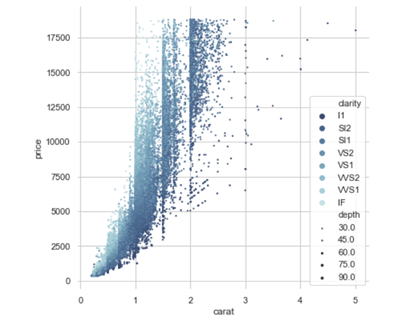import pandas as pd import seaborn as sns import numpy as np ar=np.random.randn(20,4) df=pd.DataFrame(ar,columns=[‘a‘,‘b‘,‘c‘,‘d‘]) df[‘e‘]=pd.Series([‘one‘,‘one‘,‘one‘,‘one‘,‘one‘,‘one‘,‘two‘,‘two‘,‘two‘,‘two‘ ,‘two‘,‘two‘,‘two‘,‘two‘, ‘three‘,‘three‘,‘three‘,‘three‘,‘three‘,‘three‘]) sns.scatterplot(df[‘a‘],df[‘b‘],hue=df[‘e‘])
<matplotlib.axes._subplots.AxesSubplot at 0x1a184de2b0>

import seaborn as sns import matplotlib.pyplot as plt sns.set(style="whitegrid") # Load the example iris dataset diamonds = sns.load_dataset("diamonds") # Draw a scatter plot while assigning point colors and sizes to different # variables in the dataset f, ax = plt.subplots(figsize=(6.5, 6.5)) sns.despine(f, left=True, bottom=True) clarity_ranking = ["I1", "SI2", "SI1", "VS2", "VS1", "VVS2", "VVS1", "IF"] sns.scatterplot(x="carat", y="price", hue="clarity", size="depth", palette="ch:r=-.2,d=.3_r", hue_order=clarity_ranking, sizes=(1, 8), linewidth=0, data=diamonds, ax=ax)
<matplotlib.axes._subplots.AxesSubplot at 0x1a1fe877f0>

2.2 连续型随机变量
import matplotlib.pyplot as plt import seaborn as sns # 数据集 data = sns.load_dataset("fmri") print(data.head()) # 绘画折线图 sns.relplot(x="timepoint", y="signal", kind="line", data=data, ci=None) # 显示 plt.show()
数据挖掘实践(6):基础理论(六)数学基础(六)概率(二)随机变量
原文:https://www.cnblogs.com/qiu-hua/p/14321644.html